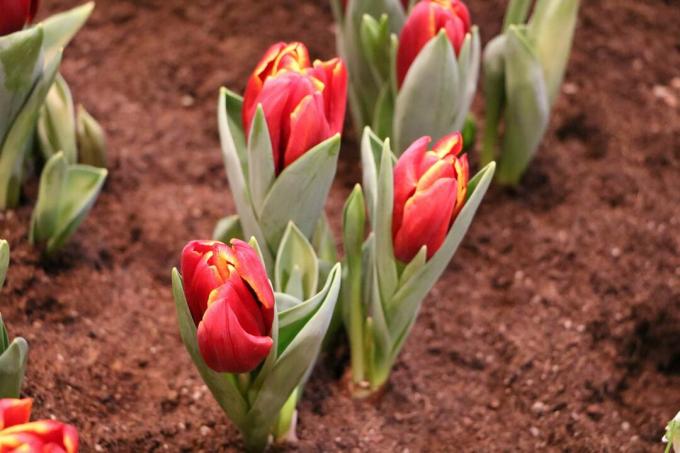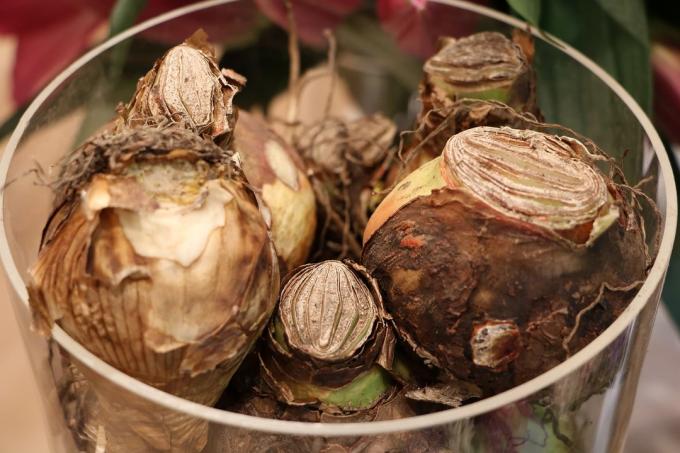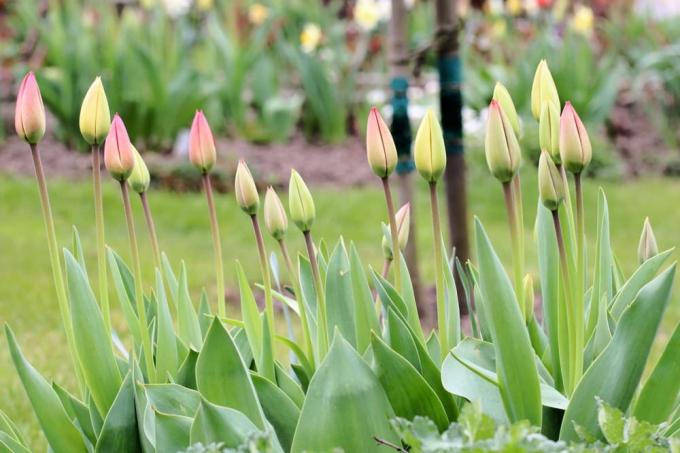

Table of contents
- Inappropriate location
- Unfavorable weather conditions
- Insufficient fertilization
- pest or disease infestation
- Wrong planting
- Too early pruning
- Too many scallions
- Previous seed formation
Perennial tubers in particular need intensive care in order to develop their annual blooms. The causes of the lack of flowers and the appropriate treatment measures are therefore listed below.
Inappropriate location
The tulips prefer a sunny to half-shady location. This should be exposed to direct sunlight for at least six hours a day. An alignment to the north is therefore ruled out. Rather choose a place in the south or south-west direction to ensure sufficient irradiation. In addition, the chosen place should provide protection from the wind. Strong gusts can cause the stems to snap off.
In addition, the existing substrate should have a loose and humus-rich consistency. The onions do not tolerate overly compacted soil in particular. Therefore, loosen the soil in advance with sand, clay or gravel.
Unfavorable weather conditions
The onion needs an appropriate balance of warmth and humidity for the development of the flowers. The tuber plants can only cope to a limited extent with particularly adverse weather conditions such as persistent frost or heavy rainfall. As a result, instead of the opulent flowers, the rather simple leaves are formed. In order to protect the offspring, it is therefore advisable to set up a canopy. This can either be made of plastic, but also made of glass. In addition to keeping out the annoying moisture, the temperature is also kept much more stable.
Tip:
When using a gapless hood, make sure that it is aired regularly. Otherwise there is a risk of mold due to the high moisture content!
Insufficient fertilization
The annual sprout of the leaves and flowers always requires Tulipa to use nutrient and energy supplies. If these are at a level that is too low, only leaf growth is promoted. For a full supply of nutrients, the use of an organic-based complete fertilizer is recommended.
Suitable fertilizers are:
- mulch
- compost
- slurry
- Damn
- nettle manure
- horn shavings
- organic liquid fertilizer
After the old flowers and leaves have dried completely in autumn, the soil should be prepared for the next flowering period with a slow-release fertilizer. After the first shoots have formed, a renewed fertilization should be carried out.
pest or disease infestation
Mainly already weakened tulip bulbs are attacked by pests and pathogens. The main cause of a weak tuber is insufficient care or an unsuitable location. Various pathogens such as fungi and viruses have an easy time with these plants. As a result, they often cause complete death. Apparently healthy plants can also be affected by exposure to air or moisture. Visibly changed Tulipa should therefore be disposed of as soon as possible.
The most common pest encountered is the vole. This approaches via its underground passages and then eats large parts of the onion. The killing of rodents is forbidden in this country, which is why they may only be expelled.
Appropriate home remedies are:
- fermented buttermilk
- Garlic
- herbal oil
- Spruce or thuja manure
- alcohol
A notice:
Alternatively, wire mesh available from specialist retailers can also be placed around the plants. However, a regular check for holes must be carried out.
Wrong planting
When planting new tubers, it is important to ensure that the time is right and that the planting depth is appropriate. Ideally, planting takes place in autumn before the first frost. However, the maximum temperature should not exceed 10 degrees Celsius. This allows the onion to take root sufficiently in the soil before winter dormancy. If the planting is done too late, it will either die or develop its root system in the following spring.

In addition, planting too deep uses up important nutrient reserves. These are actually needed for the formation of the flowers. Therefore, be sure to dig an appropriate hole. As a rule of thumb, the hole should be no more than twice as deep as the tuber is high. However, the deepest point should not be less than 30 centimeters from the earth's surface.
A notice:
In order to provide each individual tuber with sufficient space for its growth, a planting distance of 15 centimeters should also be maintained.
Too early pruning
As the leaves dry up, Tulipa begins to store the remaining nutrient reserves. This primarily serves to prepare for the next year's flowering. Cutting back the above-ground parts of the plant too early prevents exactly this aspect. Even if the dried plant is not an eye-catcher, the leaves should remain on the plant until they wither completely.
A notice:
Completely dried leaves can be recognized by a uniform brown color and a dry structure. However, the above-ground parts can definitely be cut back by the end of autumn at the latest.
Too many scallions
In addition to propagating via seeds, Tulipa forms bulbs. These grow right next to the mother onion and get their nutrients from it. A large number of daughter onions is therefore associated with a high mineral requirement. If this cannot be covered, the tulip acknowledges this with the absence of flowers.

Therefore, dig up all tubers every year and examine them for new bulbs. Autumn is the best time to check. In the best case, the work is directly linked to the fertilization. The onions should then be buried in another spot.
Previous seed formation
After the inflorescences have withered, the tulip begins to form seeds. This process costs the plant a lot of energy and uses up the nutrient reserves. In order not to unnecessarily burden the existing depots, the withered flowers should be removed regularly. Another option is to cut off the flower stalks early for use as cut flowers.
 Home editorial office
Home editorial office
Learn more about flower bulbs

Madonna lily, Lilium candidum: 9 care tips
Due to its growth height of more than one meter and the imposing white funnel-shaped flowers, the Madonna lily is one of the most impressive native bulbous plants. What to look out for when caring for this impressive flower is summarized in 9 clear care tips.

Daylilies, Hemerocallis: care from A – Z
Daylilies (Hemerocallis) are among the loveliest and most rewarding flowering perennials. Even if each individual blossom lasts only one day, countless new blossoms form again and again and decorate the garden for weeks. In addition, they are available in almost every color imaginable.

Freesia, Freesia: care tips from A - Z
Freesias are popular summer plants because they are colorful and have a pleasant, delicate scent. The irises, originally from Africa, are not difficult to care for, but do not tolerate frost. You can easily propagate the freesias yourself using the bulbs.

Milk Star, Ornithogalum: care from A to Z
The Orange Milk Star (Ornithogalum dubium) is a popular ornamental plant from the Cape Province. Because of its decorative flowers, it is often used as a cut flower in flower arrangements. The ornamental plants are undemanding, but should be cared for with caution due to their toxicity.

Checkered flower: care from A to Z | Instructions
The checkered flower (Fritillaria meleagris) attracts everyone's attention with its bell-shaped flowers. The reason for this is their striking pattern, which is strongly reminiscent of a chessboard. This striking check pattern shows the bulb flower in different shades.

The perfect time to plant tulips is in the fall
Planting the tulip bulbs is an exciting time before winter. Tulips need a cold stimulus to sprout in the coming season and be able to present their flowers. If the right planting time is observed, nothing stands in the way of flowering.
